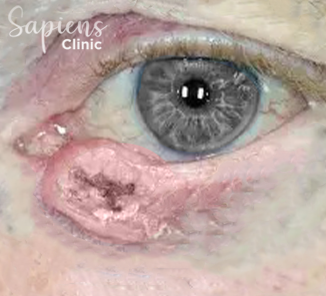Squamous Cell Carcinoma Eyelid Surgery in Malleshwaram
Specialized Diagnosis & Surgical Management at Sapiens Clinic
Squamous cell carcinoma (SCC) is a form of skin cancer that can affect the delicate tissues of the eyelid and surrounding facial areas. It typically appears as rough, scaly red patches, persistent sores, or raised growths that may bleed or crust. If left untreated, SCC can be locally aggressive and cause damage to surrounding tissues, including deeper invasion into the orbit.
At Sapiens Clinic, Malleshwaram, we offer expert diagnosis and treatment of squamous cell carcinoma of the eyelid using advanced surgical techniques, ensuring both disease control and optimal aesthetic outcomes.
What is Squamous Cell Carcinoma?
SCC originates in the squamous cells, which form the outer layers of the skin and mucous membranes. Although it can develop anywhere on the body, the eyelids are a common site due to prolonged sun exposure. This type of cancer is potentially invasive and can cause local tissue destruction or, in rare cases, spread to other parts of the body.
Signs and Symptoms
You may be dealing with squamous cell carcinoma if you notice :
- A persistent sore or scaly patch on the eyelid
- A rough, raised lesion that bleeds or crusts
- Eyelash loss or skin thickening
- Redness or ulceration that doesn’t heal
- Rapidly growing nodular mass near the eyelid margin
Early detection significantly improves outcomes and limits tissue loss.
Diagnosis and Evaluation
At Sapiens Clinic, we use a combination of clinical evaluation and histopathological examination to confirm the diagnosis. A biopsy is typically performed to analyze tissue under the microscope. In more advanced cases, imaging studies such as MRI or CT scans may be recommended to assess orbital invasion.
Treatment Options at Sapiens Clinic
1. Surgical Excision with Frozen Section Control
This technique involves removing the visible tumor along with a margin of healthy tissue. The excised tissue is immediately frozen and examined to confirm complete removal of cancer cells. Additional tissue is removed if necessary. This ensures precision and reduces recurrence risk.
2. Mohs Micrographic Surgery
In cases where preservation of surrounding healthy tissue is essential (e.g., near the eye), Mohs surgery offers the highest cure rate with minimal tissue removal. Layer-by-layer removal and microscopic evaluation continues until no cancer cells remain.
3. Reconstructive Surgery
After tumor removal, we restore both function and appearance using specialized reconstructive techniques :
- Tenzel Flap
- Mustarde Flap
- Hughes Procedure
- Cutler-Beard Flap (for full-thickness upper eyelid defects)
Our surgical team ensures eyelid mobility, protection of the cornea, and natural appearance.
Recovery After Surgery
Recovery depends on the extent of the tumor and reconstructive work involved. Most patients can resume light activities within a week. Swelling, bruising, or mild discomfort may occur initially but subside over time. Detailed postoperative care instructions, including wound care and medications, will be provided.
Why Choose Sapiens Clinic, Malleshwaram?
- Experienced oculoplastic surgeons with expertise in eyelid oncology
- Precision diagnostics and individualized treatment plans
- Access to reconstructive techniques for functional and cosmetic restoration
- Advanced surgical technology and compassionate care
FAQs
1. Is squamous cell carcinoma of the eyelid dangerous?
Yes, it can invade surrounding tissues and, if left untreated, may extend to the orbit or even the brain in rare cases.
2. How is SCC of the eyelid diagnosed?
Through clinical examination followed by biopsy and, if needed, imaging tests to assess deeper involvement.
3. Will I have visible scarring?
Our reconstructive techniques are designed to minimize visible scarring and restore a natural appearance.
4. Is surgery the only treatment?
Surgery is the gold standard, but in select cases, adjunct radiation or topical therapy may be used.
5. What is the risk of recurrence?
With precise excision or Mohs surgery and regular follow-up, recurrence risk is minimal.

Leave a Reply